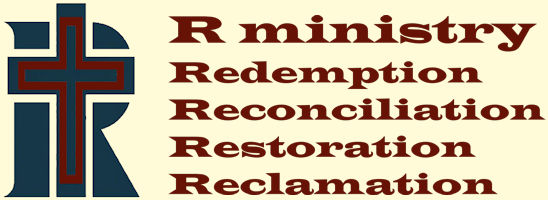
The Masonic Ritual of Baseball
By Pilgrim - 2009, using much content found elsewhere on the internet.
UPDATE: This article has since been published in book form, in a book Titled RITUAL AMERICA by Adam Parfray & Craig Heimbichner - 2012 pages 20-21
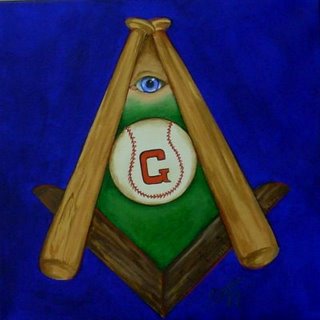
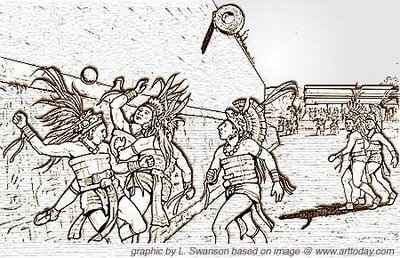 Appropriately called 'America's Pastime", baseball is less a sport than it is a ritual. It is slow paced, the players
are immobile most of the time, standing on geometric shapes. The philosopher Morris Raphael Cohen
described baseball as a national religion. Almost all ancient civilizations had some sort of ritualistic sporting
events that mixed athletic prowess and religious beliefs.
Appropriately called 'America's Pastime", baseball is less a sport than it is a ritual. It is slow paced, the players
are immobile most of the time, standing on geometric shapes. The philosopher Morris Raphael Cohen
described baseball as a national religion. Almost all ancient civilizations had some sort of ritualistic sporting
events that mixed athletic prowess and religious beliefs.
The Mayan's ball game, which resembled somewhat
our basketball. The goal was to get the ball through one of the rings situated about 20 feet above the players
without the use of hands. This game was a solemn experience, filled with ritual importance. Religious leaders
attended, as did most chieftains and other government leaders. Sacred songs were sung and the games
usually finished with a human sacrifice. The ball, the shape of the court and the rings all had important
meanings in Mayan beliefs.
Playing ball engaged one in the maintenance of the cosmic order of the universe
and the ritual regeneration of life. It was a game of chance, skill and trickery reflecting life. The team effort
engaged individuals in shared behaviour and culture, introducing, reinforcing and reinventing the game of life
and peoples' place in the cosmic order.
Are we that different from the Mayas, the Greeks, the Romans and almost all other civilizations? Well, the
Freemasons, the most prominent society in America, are IMMENSELY inspired by ancient cultures like the
Egyptians, Babylonians and Phoenicians. They study their rituals, their mythology and their knowledge
of mathematics, geometry and astrology. Is it possible that the Masons devised their own "ritual" game which
celebrates their sacred symbols?
American Freemasonry's history goes back as far as American History, in some ways they are parallel.
George Washington was the Grand Master of a Lodge, and there were even actions taken to create the rank of
Grand Master of the whole of the United States for him. According to the Grand Lodge of Texas, "On September
18, 1783, President George Washington dressed in his Masonic apron, leveled the cornerstone of the United
States Capitol with the traditional Masonic ceremony. If you've watched, the documentaries "Riddles in
Stone", or "America's Secret Beginnings", you've learned that masonic and occult symbols appear prominently all
over Washington DC. The White House is situated at the tip of a large compass created by Vermont Avenue
and Connecticut Avenue as they lead north. Of course, the emblem of Freemasonry is a compass overlapping
a square (the tool). Masonic geometry and numerology (the sacred numbers) are appear on the streets as it
appears on the field.
A Little History:
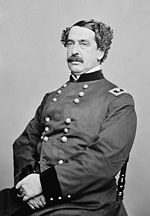
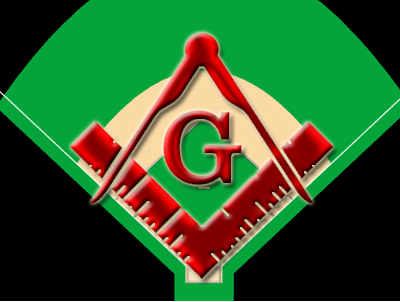 The invention of baseball is usually credited to Abner Doubleday in 1870. Doubleday was a United States Army
officer and Union general in the American Civil War. After he retired, he became a prominent member of theTheosophical Society, an organization that researches the esoteric and the occult. There is no doubt that he
had extensive knowledge of occult symbols, sacred geometry and numerology. There is more about this man later in this article.
The invention of baseball is usually credited to Abner Doubleday in 1870. Doubleday was a United States Army
officer and Union general in the American Civil War. After he retired, he became a prominent member of theTheosophical Society, an organization that researches the esoteric and the occult. There is no doubt that he
had extensive knowledge of occult symbols, sacred geometry and numerology. There is more about this man later in this article.
The Square and the Compass.
While almost all sports are played on rectangular fields or rinks, baseball is played on a peculiar shaped field
which contains figures considered "sacred geometry" in masonic teachings.
The field bears an astonishing
resemblance to the Square and Compass of Freemasonry. The field, from home plate to the left and right field
wall forms a compass; the entire outfield wall is the semicircle which this compass draws. Upside-down,
overlapping this compass, the bases form the square. Thus, the baseball field is the emblem of Freemasonry.
This is what the Masonic Lodge of BC have to say about the compass and the square:
"The square and compasses are the oldest, the simplest, and the most universal symbols of
masonry. All the world over, whether as a sign on a building, or a badge worn by a Brother, even
the profane know them to be emblems of our ancient Craft."
Some Years ago, when a business
firm tried to adopt the square and compasses as a trademark, the [USA] Patent Office refused
permission, on the ground, as the decision said, that "there can be no doubt that this device, so
commonly worn and employed by masons, has an established mystic significance, universally
recognized as existing; whether comprehended by all or not, is not material to this issue." They
belong to such, alike by the associations of history and the tongue of common report.
The Checkerboard:
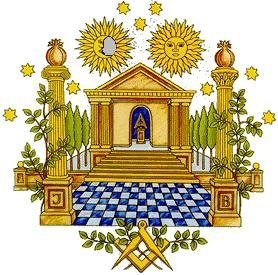
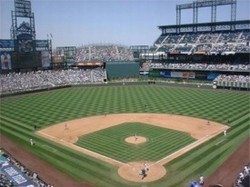 Although this is a newer addition to baseball the checkerboard field is also significantly masonic.
The checkerboard pattern is found on the floor of most masonic lodges, and even in Mormon temples, which we know are of masonic origin.
The checkerboard is referred to as the "Path of Life" or "game of life", and those who play upon it are "Pawns in the game". It's meaning is that of the duality of life usually represented by black and white squares, but in the case of baseball, by contrasting squares from colors of green. This duality shown in squares represents the physical duality of life, as opposed to the spiritual duality represented by circle diagrams such as the ying-yang symbol.
Although this is a newer addition to baseball the checkerboard field is also significantly masonic.
The checkerboard pattern is found on the floor of most masonic lodges, and even in Mormon temples, which we know are of masonic origin.
The checkerboard is referred to as the "Path of Life" or "game of life", and those who play upon it are "Pawns in the game". It's meaning is that of the duality of life usually represented by black and white squares, but in the case of baseball, by contrasting squares from colors of green. This duality shown in squares represents the physical duality of life, as opposed to the spiritual duality represented by circle diagrams such as the ying-yang symbol.
It might also have meaning where the ball lands or is intercepted on the field as to which square it comes upon, a darker green, or lighter, but that is speculation.
Numerology
The numerology aspect of baseball is something to look at closely because it relates directly to the sacred
numbers. You will notice that almost all numbers related to baseball are multiples or divisors of 9.
3 strikes
3 outs
9 fielding positions
9 innings
27 outs per game
81 homes games
81 games on the road
In Freemasonry, nine derives its value from its being the product of three multiplied into itself,
and consequently in Masonic language the number nine is always denoted by the
expression three times three. For a similar reason, 27, which is 3 times 9, and 81, which is 9
times 9, are esteemed as sacred numbers in the advanced Degrees.
-Masonic Dictionary
Every one is aware of the singular properties of the number nine, which, multiplied by itself or
any other number whatever, gives a result whose final sum is always nine, or always divisible
by nine. Nine multiplied by each of the ordinary numbers, produces an arithmetical
progression, each member whereof, composed of two figures, and presents a remarkable
fact.
9 . 18 . 27 . 36 . 45 . 54 . 63 . 72 . 81 . 90
So, 0+9=9, 1+8=9, 2+7=9 and so on. Also, there are mirrors of numbers that are important like 18 and 81, 27 and 72, 36 and 63, 45 and 54. For all those reasons, 9 and its multiples are considered sacred.
The three bases represent the three degrees of the Blue Lodge, and in order to score or succeed the player must reach home plate in order to advance to the further degrees.
Here's what those studied in the occult have to say about the occult kabbalistic ritual of Baseball:
THE SACRIFICE FLY
The BATTER at home plate is actually the BAITER, and like BAIT, as the BATTER hits the Ball, the masses get
hooked in the excitement and just like MAGIC lend their intense focus and energy to this
kabbalistic ritual. There is no way that the coming world devastation could ever come to
fulfillment without the use of mass media and the luciferian kabbalistic rituals we call sports,
religious gatherings, political rallies and elections, and just general entertainment. All this had to be
put in place first, or none of the killing and natural disasters could ever be accomplished on a
worldwide scale, and still be undetected as to who is responsible for them.
This is symbolized in the Caduceus of Hermes, or the
Caduceus of Mercury medical symbol, where we see two snakes intertwining around a pole with
wings that represent the spirit of god. It is this SION serpent, which again is the ZION serpent that is
the Serpent of duality that is the driving force behind all sporting events and the Olympic games.
The game on the diamond was played out so that the accuser(pitcher) could not
rule over man, but the law would. The accuser stands upon the mound 66 gilgul, or the place of the
skulls. This is also the same spot as the masonic "G" in the square and compass design. So the accuser stands in the place of God or "Grand Architect" as the masons call it. The accuser's dominion is the cycles of birth and rebirth, or if you are counting, 60 feet
6 inches.
The accuser stands upon the mound to split the accused(batter) in two. He is trying to rule over the batter by
accusing the batter. The accusation splits the batter in two.
To understand this better, Jesus stands before Pilate, and Pilate gives the crowd a choice,
Jesus, King of the jews, or Joshua Bar Abbas, Jesus son of the father. It's the same person,
there is no other person there. What Pilate did is make the crowd choose, thereby giving
himself authority over the death of Jesus. The fact is Pilate split the name in two to create that
duality to use the power of death against Jesus. He accused him and split him in two.
Back to baseball. The accuser is there to split the batter in two. The baseball represents the
pod, or the Power Of Death.
The BAT represents the whole of the law. And by the law the accuser is thwarted, so that he can not use the power of death, against the batter.
The batter is like Job, he takes a side, but that leaves the other side unprotected. This is
why the batter must be successful at least one third of the time, hence three strikes and you are out.
When the batter takes a side, he is unprotected and the accuser
will surely broadside him, this is why the bat protects the other side. With the
breakdown of the law, the accuser finds his weakness and exploits it to make him fear the limit
of death, and make him believe he has power over his life.
To get away from the accusing finger of the pitcher, and the judgement of
his side, the batter must hit the ball (pod) or power of death, where the accuser is not.
Now the Ball represents the power of death. Death only gets it's power from your belief in it.
The people of the United States had lived for a very long time without having to be fearful of the limit of death. That
too is being subverted. It started when Bush put the game on the white house lawn. He placed it
on the south garden, to overlook it, instead of facing the game north, where the law rules over all.
So the game has gone through terrific judgement since bush did that. It was no accident,
he mean't to do it.
The constitution is being categorically destroyed, because the new fields that
are being built, are trying to change the sacred geometry of the game
Babe Ruth built his house on the physical law of bat meets ball. And he hit it out of sight. but he
could not be the greatest home run hitter, simply because he began as a pitcher, and accused
many who stood and took a side before him. This is why it was left up to Aaron, his brother.
Abner means my father is light, and Doubleday explains itself. Three measures of light to the
inventor, he chose that name for a specific reason.
kabbalistically the game was created as a ritual to make men ever vigilent against the accuser,
and to innately know when he was in danger of tyranny because of the accuser. When you point the
accusing finger, three fingers point back at you.
The bat, the whole image of the law, and the ball the power of death, play out on the diamond, which
represents the three dimensional world of form, homeplate represents the body human which must
constantly beg the law to protect him against tyranny, or man's rule over man. The bases are the
paths, that are open to all to roam, when someone puts the power of death, in this case the ball
out of reach of all judgement. That is the true seed of potential and why the home run hitter is the
ultimate hero. He has used the law to free himself of all tyranny and in turn anyone on the path
at the time he has done it, all become free to roam the paths. This is kabbalistically the 32 paths
of humanity, all become open to tread upon and travel through.
This is important because it allows all men to reach their fruition in their time and in their place, the
timely hit, allows a seed of potential to reach absolute fame and fortune, and this is the crux of
the American dream.
Another meaning from the occult world:
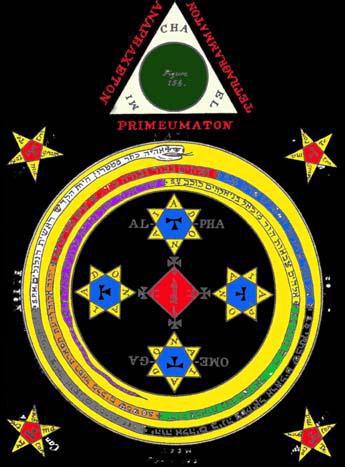 The hexagrams which must be censed deosil or counter clockwise become the bases which must
be touched by the player, the spermatozoa is replaced with a bat, the egg with the ball. The triangle
becomes the catcher which is to be evoked (or rather the crowd mesmerized) and standing behind
the form, the formless force or voice as the "umpire" often astrally seen in evocation hiding behind
the material image, and the pentagrams redirected as the fielders and shortstop.
Research further you will note there have been some rather "strange occurrences" at some
games…
The hexagrams which must be censed deosil or counter clockwise become the bases which must
be touched by the player, the spermatozoa is replaced with a bat, the egg with the ball. The triangle
becomes the catcher which is to be evoked (or rather the crowd mesmerized) and standing behind
the form, the formless force or voice as the "umpire" often astrally seen in evocation hiding behind
the material image, and the pentagrams redirected as the fielders and shortstop.
Research further you will note there have been some rather "strange occurrences" at some
games…
It's all about the ancient practice of human sacrifice. That's what baseball is
really about, killing for "sport." The term "be a sport" means sacrifice something for the team, go
along with it. The ignorant were told that gods wanted blood from them because they were bad, so
he sent lightning down and so forth.
You'll take one for the team because there are too many spectators and not enough people who
know what the game is really about. It's about human sacrifice. It goes back to the pyramids
represented by the diamond, the mound, ancient symbols that are hidden before our eyes and too
few really view them as they are meant to be viewed.
Famous Freemasons and baseball go hand in glove, so to speak.
Rogers "The Rajah" Hornsby, an original member of the Baseball Hall of Fame is listed on Masonic sites among the famous. The baseball stars are a who's who of famed Freemasons: Grover Alexander,
Ty Cobb, Carl Hubbell, Branch Rickey, Honus Wagner, and Cy Young, to name a few.
Abner Doubleday (June 26, 1819 - January 26, 1893) is often, folklorically, said to be one of the two "Fathers" of American baseball. Allegedly Doubleday played the first game at Cooperstown,
New York in 1839, and that's the reason the Baseball Hall of Fame is located there, so the story goes.
Doubleday was a career United States Army officer and Union general in the American Civil War. He fired the first shot in defense of Fort Sumter, the opening battle of the War Between The States.
This happened on the northern 33rd degree of latitude, at Fort Sumter and is so noted in Masonic decipherings. Doubleday had a pivotal role in the early fighting at the Battle of Gettysburg, too,
where he had his finest hour, but his relief by Major General George G. Meade caused lasting enmity between the two men.
In 1871, Doubleday commanded the 24th U.S. Infantry, an all African-American regiment, in Texas. He retired from the Army in 1873, and in San Francisco, after the war,
he obtained a patent on the cable car railway that still runs there.
By 1878, he was living in Mendham, New Jersey, from where, that year, he became a prominent member of the Theosophical Society. When two of the founders of that society,
Helena Blavatsky and Henry Steel Olcott, moved to India at the end of that year, he was constituted as the President of the American body.
In addition, he is known for a popular myth that he invented baseball, which has been debunked by almost all sports historians. The lore of baseball credits Doubleday with inventing the game,
supposedly in Elihu Phinney's cow pasture in Cooperstown, New York, in 1839.
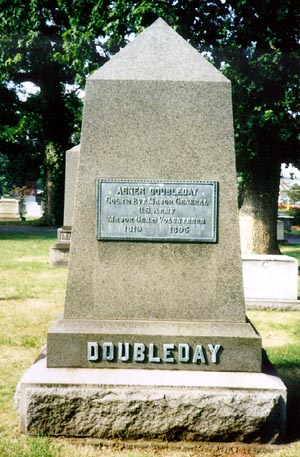 Joseph E. Chance writing biographically in the book, My Life In The Old Army by Abner Doubleday (New-York Historical Society, 1998), claims:
Joseph E. Chance writing biographically in the book, My Life In The Old Army by Abner Doubleday (New-York Historical Society, 1998), claims:
A letter from Albert Graves, a resident of Cooperstown, New York, and neighbor of Doubleday, is the only documentation remaining of Doubleday's connection to baseball.
Graves asserted that Doubleday had taught the Cooperstown boys his modifications of a game known as "town ball." The changes to town ball included reducing the number of players,
assigning each player a location in the field, and replacing the wooden posts designated as bases by flat stones....Sports writers,
functioning in our new order of "political correctness" now claim that the first game of baseball played in Texas, supposedly at Galveston,
was not organized by Doubleday while stationed there in 1867! Doubleday was indeed stationed in Galveston on this date, serving as colonel of the 17th Infantry,
sent to impose military rule on a defeated nation.
The Mills Commission, chaired by Abraham G. Mills, the fourth president of the National League, was appointed in 1905 to determine the origin of baseball.
The committee's final report, on December 30, 1907, stated, in part, that "the first scheme for playing baseball, according to the best evidence obtainable to date,
was devised by Abner Doubleday at Cooperstown, New York, in 1839."
Baseball historian George B. Kirsch has described the results of the Mills commission as a "myth." Moreover, Doubleday himself never made such a claim,
but his biography notes this has to do with Doubleday's "Christian modesty."
Of course, it didn't help that only the testimony of Graves, who would have been five in 1839, is the sole proof of the Doubleday tale.
It also doesn't assist the story that Graves' reliability as a witness was questioned as the years went by because he was later convicted of murdering his wife
and spent his final days in an asylum for the criminally insane.
Was Abner Doubleday a Freemason? There seems little proof of that. Still, the synchromystic underpinnings of Abner Doubleday's life,
from that first shot at Fort Sumter to the President of the Theosophical Society to his final resting place at Arlington National Cemetery with an obelisk as his tombstone
(Plot: Section 1, Grave 61), should not be understated.
Alexander Cartwright, Jr.
Most baseball historians, however, note that the links between Alexander Joy Cartwright, Jr. and the origins of American baseball are much more secure.
I also would say that there is no doubt as to Cartwright's heavy Masonic involvements.
Born in New York City on April 17, 1820, to Alexander Joy Cartwright Sr., a merchant sea captain, and his wife Esther Burlock Cartwright,
Alex Jr. began his working life in 1836 as a clerk at the age of sixteen in Coit & Cochrane, a broker's office on Wall Street.
Coit is an incredibly significant name in cryptopolitical history, from Wall Street to Skull & Bones to the firefighter's monument in San Francisco called Coit Tower.
(I will have more to say about that name at another time.)
Intriguingly, Cartwright's involvement with baseball also directly overlaps with his involvement in firefighting in New York City, as well as later in his life.
Here is a passage from Mr. Baseball's look at this history:
Many of these ball-playing young men, including Cartwright, were also volunteer firemen. The first firehouse that Cartwright was associated with was Oceana Hose Company No. 36.
Later, he joined Knickerbocker Engine Company No. 12, located at Pearl and Cherry Streets. It disbanded in 1843.
Some speculate that the young ballplayers, possibly Cartwright himself, named their ball club after the engine company, apparently sometime between 1842 and 1845.
A huge fire in July 1845 destroyed the Union Bank where Cartwright was employed. Consequently, Alex went into the book-selling business with his brother Alfred on Wall Street.
They did not give up on their ball playing, though. Meanwhile, the city was growing and changing all around them.
The Knickerbocker Base Ball Club ventured across the Hudson River by ferry to Hoboken, New Jersey. There they found a roomy spot called Elysian Fields.
The team drew up a constitution and bylaws on September 23, 1845, and twenty rules in all were adopted.
The Knickerbocker rules are also synonymously known as the "Cartwright Rules". Cartwright and his friends played their first recorded game on October 6, 1845,
and continued playing well into late autumn that year. Receipts exist for dinners that are dated December 5, 1845,
and are labeled with "Elysian Fields Hoboken for twenty dinners at $1.50 each for the Knickerbocker Base Ball Club."
The first match game was played between the Knickerbockers and the New York Club on June 19, 1846, at Elysian Fields.
Cartwright followed the Gold Rush of 1848 to San Francisco when he moved his family there in March 1849, and then on to Hawaii in August 1849.
Knickerbockers
Interestingly, both Doubleday and Cartwright would turn up in San Francisco, historically. The link between New York and San Francisco can be shown easily, and one thread is the name Knickerbockers.
The term "Knickerbockers" began with Washington Irving's History of New York, (published 1809). Still further, the family name "Knickerbocker" can be traced to a single Dutch settler who immigrated to what is now New York in the late 1600s. By the late 19th century, the term had come to mean the style of breeches the settlers wore that buckled just below the knee, which became known as "knickerbockers," or "knickers."
The name "Knickerbocker" first acquired meaning with Washington Irving's History of New York, featured the fictional author Diedrich Knickerbocker, an old-fashioned Dutch New Yorker in Irving's satire of chatty and officious local history. In fact, Washington Irving had a real friend named Herman Knickerbocker, whose name he borrowed.
Herman Knickerbocker, in turn, was of the upstate Knickerbocker clan, which descended from a single immigrant ancestor, Harmen Jansen van Wijhe. Jansen van Wijhe invented the name upon arriving in New Amsterdam and signed a document with a variant of it in 1682. After Irving's History of New York, by 1831, "Knickerbocker" had become a local nickname for quaint Dutch-descended New Yorkers, with their old-fashioned ways and their long-stemmed pipes and knee-breeches long after the fashion had turned to trousers.
Thus the "New York Knickerbockers" were an amateur social and athletic club organized on Manhattan's (Lower) East Side in 1842, largely to play "base ball" according to written rules; on June 19, 1846 the New York Knickerbockers played the first game of "base ball" organized under those rules, in Hoboken, New Jersey, and were trounced 23 - 1.
Today, the name survives most overtly in the National Basketball Association team, the New York Knicks, short for Knickerbockers.
"Firebelle Lil" Coit, the benefactor of San Francisco's Coit Tower, gave the money for the structure in the name of that West Coast city's Knickerbocker Engine Co. 5, and also commissioned another neighborhood landmark, a statue of three firefighters on the southwest corner of Washington Square Park.
It seems clear that the "Knickerbocker" name in San Francisco has its roots in New York City, via the fire departments, specifically.
Elysian Fields
Cartwright's Knickerbockers had to play someplace, and intriguingly, the "base ball" team found a "roomy spot called Elysian Fields" in Hoboken, New Jersey.
Colonel Jacob Stevens, who would later helped found Stevens Institute of Technology (one of the top engineering institutions in the United States),
owned an expanse known as the Elysian Fields. In about 1870, Stevens sold the Elysian Fields for a handsome profit, and today's street grid was laid out, carving up the site.
A small passive and children's park bordered by Hudson Street, the right-of-way of 10th Street, and Frank Sinatra Drive bears the name "Elysian Park," the last vestige of Col. Stevens' Elysian Fields.
(The Stevens Institute of Technology is named after a family of accomplished inventors and engineers. In 1784, the land now occupied by Stevens Institute of Technology was purchased by John Stevens,
who would later reverse engineer the British steam locomotive to American standards for domestic manufacture. Robert Stevens, one of John Stevens' sons is known for inventing the flanged T rail,
a form of railroad rail in use today throughout the world. With his brother Edwin A. Stevens, Robert created America's first commercial railroad. When Edwin A. Stevens died in 1868,
he left a bequest in his will as an endowment for the establishment of an "institution of learning", providing his trustees with land and funds.)
The intersection of 11th and Washington, where the Hoboken Industry and Business Association monument to baseball now stands,
was converted into a full-fledged baseball tribute during the renovation of all of Washington Street in 2003. The intersection was repaved in brick,
with the outline of a baseball clearly visible in the center and each of the four corners being designated as a "base' with the appropriate markings H, 1, 2, 3, according to Charles O'Reilly in 2005.
Needless to say, "Elysian Fields" carries a significant name.
The Elysian Fields, or the Elysian Plains, among the Greeks, was considered the final resting place of the souls of the heroic and the virtuous.
In Greek mythology, Elysium (Greek: ?????? ?????) was a section of the Underworld (the spelling Elysium is a Latinization of the Greek word Elysion).
Elysium is an obscure and mysterious name that evolved from a designation of a place or person struck by lightning, enelysion, enelysios.
This could be a reference to Zeus, the god of lightning, so "lightning-struck" could be saying that the person was blessed (struck) by Zeus (lightning).
Scholars have also suggested that Greek Elysion may instead derive from the Egyptian term ialu (older iaru), meaning "reeds," with specific reference to the "Reed fields"
(Egyptian: sekhet iaru / ialu), a paradisaical land of plenty where the dead hoped to spend eternity.
Several locations have taken on the name "Elysian Fields." They include, a spot near downtown Los Angeles, Elysian Park, which "is the city's oldest public park and, at 575-acres,
the second largest after Griffith Park. It is home to numerous historic sites, including the Los Angeles Police Academy and Barlow Hospital, that are linked by miles of walking trails."
The name is used for a remote section of wilderness in the northern region of Mt Rainier National Park in Washington State, and a frozen sea on Mars is called Elysium.
There is a street named Elysian in New Orleans that is a setting and a symbolic element in A Streetcar Named Desire.
Today, Elysian Fields Quarterly - The Baseball Review is a popular magazine for the baseball diehard fan.
Back to Cartwright's Masonic Links
Mr. Baseball cements the Masonic nature of Cartwright's history with this paragraph:
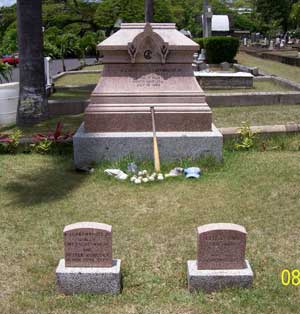 Aside from his duties at the Honolulu Fire Department, Alexander became involved with many other aspects of the city through his involvement with Freemasonry. In 1859, for example, Queen Emma and King Kamehameha IV founded Queen's Hospital. As part of its customs and traditions, cornerstone ceremonies were held for the construction of new buildings. The first public Masonic ceremony on the islands was at the laying of the hospital cornerstone in 1860.
Aside from his duties at the Honolulu Fire Department, Alexander became involved with many other aspects of the city through his involvement with Freemasonry. In 1859, for example, Queen Emma and King Kamehameha IV founded Queen's Hospital. As part of its customs and traditions, cornerstone ceremonies were held for the construction of new buildings. The first public Masonic ceremony on the islands was at the laying of the hospital cornerstone in 1860.
And further...
King Kamehameha V was the first native Hawaiian to become a Freemason. The February before he died, a cornerstone was laid in Masonic tradition with members of the lodge present, including the Acting Grand Master, Alexander Cartwright Jr. The king, together with Cartwright, spread cement beneath the Cornerstone for what would become the Judiciary Building.
The next monarch, King Kalakaua, became the first Hawaiian monarch to attend a baseball game. Cartwright was the king's financial advisor. The game took place in 1875 between the Athletes and the Pensacolas. Baseball had been growing in popularity since being played at Punahou School in the 1860s. But it is unclear whether Cartwright actually instituted the playing of the game on the islands.
At the Baseball Hall of Fame, there is a plaque upon which Cartwright is called the "Father of Modern Baseball." A large pink granite monument with suggestive symbols decorating it is to be found in Oahu Cemetery (formerly Nuuanu Valley Cemetery) in Honolulu, Hawaii. It marks Cartwright's final resting place. It has become an monument at which visitors routinely leave offerings, in the form of baseballs, bats, and baseball cards.
The name game kicks into high gear here, for Mr. Baseball writes:
Alexander Cartwright died on July 12, 1892, from blood poisoning from a boil on his neck. The Hawaiian monarchy was overthrown six months later on January 17, 1893. A group of Americans in Honolulu formed to request of President Benjamin Harrison that Hawaii be annexed to the United States. The president was in favor. The individual leading the cause for annexation was Lorrin Thurston. Coincidentally, Thurston had played baseball at Punahou School at the same time as Alexander III and Bruce Cartwright Sr.


 Appropriately called 'America's Pastime", baseball is less a sport than it is a ritual. It is slow paced, the players
are immobile most of the time, standing on geometric shapes. The philosopher Morris Raphael Cohen
described baseball as a national religion. Almost all ancient civilizations had some sort of ritualistic sporting
events that mixed athletic prowess and religious beliefs.
Appropriately called 'America's Pastime", baseball is less a sport than it is a ritual. It is slow paced, the players
are immobile most of the time, standing on geometric shapes. The philosopher Morris Raphael Cohen
described baseball as a national religion. Almost all ancient civilizations had some sort of ritualistic sporting
events that mixed athletic prowess and religious beliefs.

 The invention of baseball is usually credited to Abner Doubleday in 1870. Doubleday was a United States Army
officer and Union general in the American Civil War. After he retired, he became a prominent member of theTheosophical Society, an organization that researches the esoteric and the occult. There is no doubt that he
had extensive knowledge of occult symbols, sacred geometry and numerology. There is more about this man later in this article.
The invention of baseball is usually credited to Abner Doubleday in 1870. Doubleday was a United States Army
officer and Union general in the American Civil War. After he retired, he became a prominent member of theTheosophical Society, an organization that researches the esoteric and the occult. There is no doubt that he
had extensive knowledge of occult symbols, sacred geometry and numerology. There is more about this man later in this article.

 Although this is a newer addition to baseball the checkerboard field is also significantly masonic.
The checkerboard pattern is found on the floor of most masonic lodges, and even in Mormon temples, which we know are of masonic origin.
The checkerboard is referred to as the "Path of Life" or "game of life", and those who play upon it are "Pawns in the game". It's meaning is that of the duality of life usually represented by black and white squares, but in the case of baseball, by contrasting squares from colors of green. This duality shown in squares represents the physical duality of life, as opposed to the spiritual duality represented by circle diagrams such as the ying-yang symbol.
Although this is a newer addition to baseball the checkerboard field is also significantly masonic.
The checkerboard pattern is found on the floor of most masonic lodges, and even in Mormon temples, which we know are of masonic origin.
The checkerboard is referred to as the "Path of Life" or "game of life", and those who play upon it are "Pawns in the game". It's meaning is that of the duality of life usually represented by black and white squares, but in the case of baseball, by contrasting squares from colors of green. This duality shown in squares represents the physical duality of life, as opposed to the spiritual duality represented by circle diagrams such as the ying-yang symbol.
 The hexagrams which must be censed deosil or counter clockwise become the bases which must
be touched by the player, the spermatozoa is replaced with a bat, the egg with the ball. The triangle
becomes the catcher which is to be evoked (or rather the crowd mesmerized) and standing behind
the form, the formless force or voice as the "umpire" often astrally seen in evocation hiding behind
the material image, and the pentagrams redirected as the fielders and shortstop.
Research further you will note there have been some rather "strange occurrences" at some
games…
The hexagrams which must be censed deosil or counter clockwise become the bases which must
be touched by the player, the spermatozoa is replaced with a bat, the egg with the ball. The triangle
becomes the catcher which is to be evoked (or rather the crowd mesmerized) and standing behind
the form, the formless force or voice as the "umpire" often astrally seen in evocation hiding behind
the material image, and the pentagrams redirected as the fielders and shortstop.
Research further you will note there have been some rather "strange occurrences" at some
games…
 Joseph E. Chance writing biographically in the book, My Life In The Old Army by Abner Doubleday (New-York Historical Society, 1998), claims:
Joseph E. Chance writing biographically in the book, My Life In The Old Army by Abner Doubleday (New-York Historical Society, 1998), claims:
 Aside from his duties at the Honolulu Fire Department, Alexander became involved with many other aspects of the city through his involvement with Freemasonry. In 1859, for example, Queen Emma and King Kamehameha IV founded Queen's Hospital. As part of its customs and traditions, cornerstone ceremonies were held for the construction of new buildings. The first public Masonic ceremony on the islands was at the laying of the hospital cornerstone in 1860.
Aside from his duties at the Honolulu Fire Department, Alexander became involved with many other aspects of the city through his involvement with Freemasonry. In 1859, for example, Queen Emma and King Kamehameha IV founded Queen's Hospital. As part of its customs and traditions, cornerstone ceremonies were held for the construction of new buildings. The first public Masonic ceremony on the islands was at the laying of the hospital cornerstone in 1860.